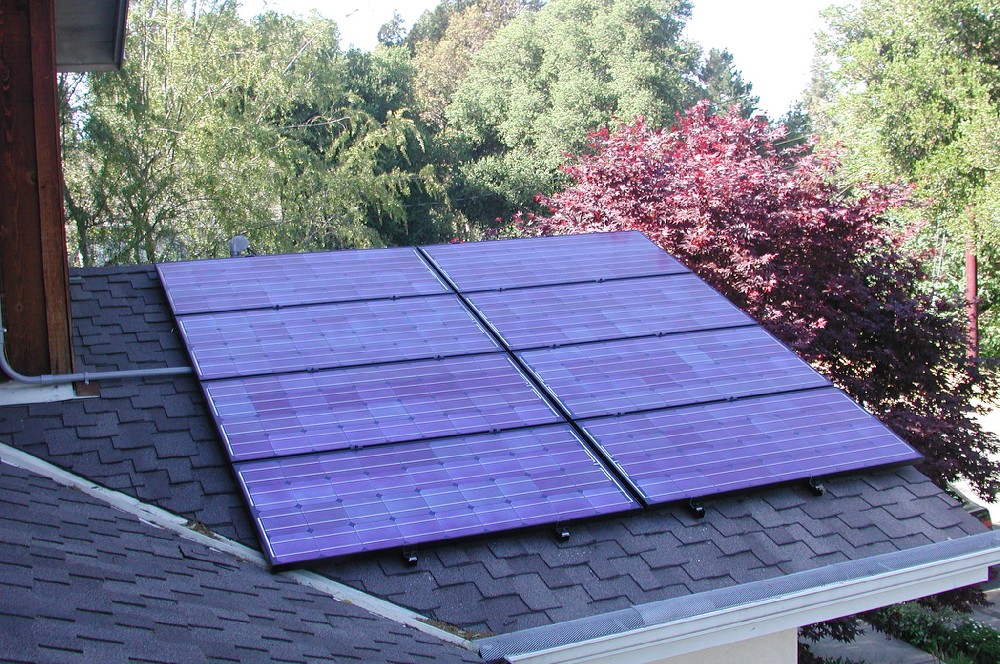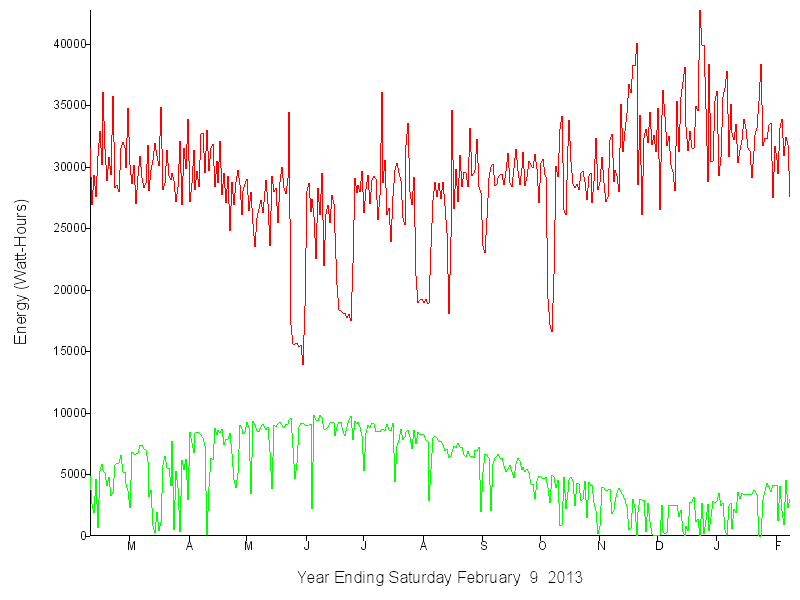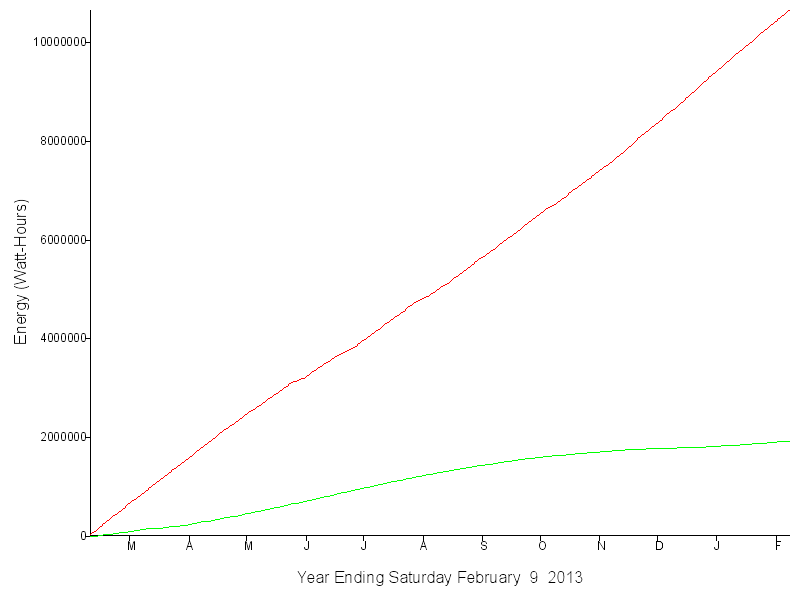NOTE: We've moved, so this page will no longer be updated. The photovoltaic system described here will remain at the old house. An upgraded system is running at the new house, but we haven't had time to create a web page for it.
Our system has been up and running since May 8th, 2001. We'll start at the top:

Above are eight of the 44 photovoltaic modules on the roof. 12 face roughly south, 16 face roughly east, and 16 face roughly west. They're positioned so that it's easy to walk around the roof for routine maintenance like cleaning gutters.
Nominally each module produces 100 watts (6.2 amps at 16 volts DC), for a total of 4400 watts. In practice, because they're not perpendicular to the rays of the sun, they get dirty, they're partially shaded by trees, etc., the total is less. The most we've ever seen is 3600 watts, and typically the output at noon is something a little over 2000 watts. We sell excess power to the City of Palo Alto during the hours of peak production, but buy power in the usual way the rest of the time. On average over a year we generate about 40% of the power we use. We're not "off the grid" though we've reduced our dependence on it.

The power from the photovoltaic modules flows to the electronics center in our basement.
On the right you can see the backup batteries. There are eight of them, rated at 255 amp-hours each. Ideally we won't discharge them to less than 40% of their rated capacity, so altogether they offer about 14 kilowatt-hours of backup power. That plus a little power from the sun is enough to last us all day. (Our rate of consumption is about 22 kilowatt-hours per day, considerably less if we're conserving.)
In the middle is the power center. Its main purpose is to regulate the flow of current from the solar array to the batteries. A "charge controller" prevents the batteries from overcharging; leftover current goes to the inverters. The power center also monitors system status and provides circuit breakers to shut down or bypass the system. The plastic conduit at the top of the power center goes to the solar array. The steel conduit at the right side of the power center goes to the ordinary circuit breaker box on the outside of the house.
On the left you can see the two inverters, which are really the heart of the system. They convert and route power automatically:
If you're familiar with the Xantrex product line, you know that they offer a 5500 volt-amp inverter that would be plenty big enough for our house. However, we elected to use two smaller inverters (rated at 4000 volt-amps each) instead. This is because we wanted to back up virtually every circuit in the house. When the inverters are not converting DC to AC, they're just passing AC power through from the utility grid to the loads in the house. Xantrex inverters will pass-through 60 amps. Under unlikely (but not too far-fetched) conditions, a bunch of appliances with heavy surge currents could start at once, causing a brief demand for more than 60 amps. By using two inverters, we can guarantee that 120 amps of pass-through current are available, so we never risk tripping an inverter's circuit breaker. As a fringe benefit, we gain the ability to put 240 volt appliances on our solar power system. Though we haven't done that so far, if there were a significant increase in the cost of natural gas, it might become economical to use the 240V supply.
If you wanted to run a larger house or one with air conditioning, electric heating, etc. you could go to a four-inverter system to get up to 240 amps pass-through current.
Total system cost including installation was about $50K. However, there are rebates for alternative power systems, and in our case we received $15K. The backup batteries account for a substantial part of the non-rebatable cost of the system; more about that below. At current Palo Alto residential power rates our payback time is about 18 years. The warranted life of the PV modules is 20 years.
If you're interested in a higher-end system, I'd suggest going for two more inverters to solve the pass-through current constraint. If you're interested in a lower-cost system, I'd suggest cutting the batteries back from 8 to 4, using a single inverter, and picking which circuits in the house should have backup power (rather than covering essentially all of them as we did). Newer inverter systems are also available that may have different tradeoffs, but we haven't researched them yet.
If there's one thing we'd do differently if we started over today, it's using fewer backup batteries. Better to put the dollars into increased generating capacity, which is also subject to rebate (whereas the batteries aren't). On the other hand, we're now pretty well equipped to deal with a long-term power outage caused by an earthquake or utility grid routing failure, and someday we may be thankful for that.
As far as maintenance goes, the one thing that seems to be necessary for consistently-high output is cleaning the PV modules. During the summer dust accumulates on them, and can reduce output by 20%. If you live in a place where it rains during the summer, this is no problem. In our case, we clean the modules with a squeegee on a long pole two or three times a year in order to maximize output.
Our big project for 2004 was to add a tuning and monitoring system. We wrote Linux-based software which runs on an otherwise-obsolete laptop computer connected by serial cables to the inverters. The software records our power consumption and generation, and balances the maximum selling amperage of the inverters so that they run as efficiently as possible. Additional software on our web server backs up the database over our local-area network and generates charts.
Here's the power produced and consumed on a day-by-day basis over the past year.

And finally, here's the cumulative energy produced and consumed over the past year:

Our system is a semicustom configuration of a package originally specified by Astropower. Xantrex (formerly Trace Engineering) produces the electronics (especially the inverters, which are truly amazing).
MC Solar Engineering worked with us to design the configuration, provided the gear, and handled all the installation.
Allen
